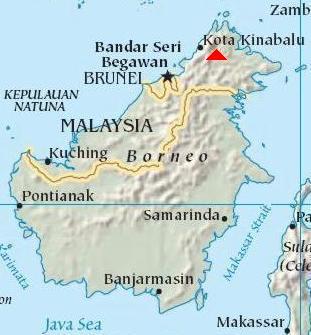
| Gunung Kinabalu - Borneo and Malaysia Highpoint |  |

|
Gunung Kinabalu is the centerpiece of the eponymous national park in Sabah Province, Malaysia on Borneo. Claimed to be the youngest pluton on Earth, it is a geological "baby" at only 1.5 million years - quite young in the grand scheme. Not a volcano, Kinabalu is an immense mass of granite reaching high enough as to have been scoured by glaciers in past Ice Ages. Above 12,000 feet the rock is smooth, with obvious striations. There's even a mountain horn - all features signifying glacial passage.9

|
| Gunung Kinabalu |
Declared a World Heritage Site, this 13,455 foot mountain is celebrated locally and nationally as a natural treasure - and the national park was built around it to encompass and so protect a panoply of indigenous flora and fauna.
Kinabalu is ranked number 20 on the Earth's Fifty Finest prominence list - easily the most prominent peak of our journies. As a national highpoint and one of the Seven Islands highpoints, these superlatives logically make it our most coveted goal. Seven Islands are the largest seven islands on Earth, starting with Greenland, and is an analog to the famed Seven Summits of mountaineering interest.

|
|
Kinabalu trailhead with Robert (right), guide, and Adam (left). |
Tourists also climb the peak, and this, together with a hard-limit of 130 hikers allowed to summit each day, makes for a tricky upper hut reservation system.
From the Park entrance it is some 8,000 feet of vertical gain - of which 1,000 feet can be shaved-off by taking a park bus to road's end. Still, climbing (and descending) 7,000 feet in one day is beyond the ability of nearly all hikers - and especially tourists who generally haven't much experience in these matters.
Thereby a set of huts sit at just over 11,000 feet, and one is expected to sleep there prior to a 3 a.m. start for the summit. For permission to climb the peak one must have reservations at these Laban Rata huts.

|
|
Typical trail conditions below the Laban Rata huts. |
Basically, no reservations translates to no summit, and we were unaware of this prior to making flight arrangements. Indeed, the tightness of room availability exceeds that of seats on international flights. Therefore it is advised that one secure hut reservations and then purchase airplane tickets - topsy-turvy compared with how one normally arranges a long journey.
There is one exception. If one can convince the park authorities that one is sufficiently fit, the peak may be climbed in a single day, i.e. without having to sleep at the upper huts. Furthermore, camping on the mountain is prohibited - were it to be allowed, one could have a two-day climb without hut reservations. Red tape. I hate it.
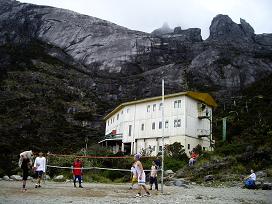
|
| main building at Laban Rata |
Thus Bob and I come with printed climbing resumés demonstrating our experience - but not necessarily our fitness levels. I worry about Bob since, at age 70, an observer would think him unfit for such an adventure. Permission to climb in one day is rarely granted.
Our inbound flight from the states arrives at Kuala Lumpur International Airport by late evening. The flight to Kota Kinabalu ("Kinabalu City") departs just after sunrise some six hours later, out of a different airport that serves domestic flights. After a hasty taxi ride, we sit out the flight, sans sleep, overnight in the terminal. The air conditioning is essential, and hits us like a splash of cold water upon entering from the intensely muggy taxi stand.
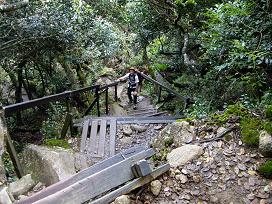
|
|
Adam at a steeper section above Laban Rata. |
We clearly need a night's sleep on arriving at the park entrance around noon. The plan is to request climbing the peak in a single day, tomorrow, after staying the night at our lodge near the park entrance - and for which we have reservations.
Kota Kinabalu (henceforth, "KK") is the main Malaysian city on Borneo. A medical doctor in KK, Ruhaizad Daud, secures these reservations a week before our journey. Ruhaizad is well-versed in English, and takes interest in helping travelers with questions about Kinabalu Park. His website contains a wealth of information for tourists, regardless of whether they wish to climb the peak or just explore the park in general.

|
|
Glacier-carved horn by dawn's light. |
A cancellation at the Laban Rata huts leaves space this evening. That's a huge windfall, especially for Bob. We are offered that space, and, after accepting this invitation for a two-day climb, madly spend one hour changing clothes while arranging all gear and belongings for the effort.
A cup of the blackest coffee in a nearby eatery sets me in motion. This is insane - climbing nearly 5,000 vertical feet without having slept the night.
One is required to have a guide on-trail. The lady, in her twenties, seems to be the only female guide of the bunch. We are issued personal ID badges with our names and date of entry - a system to foil those who would climb the peak without permission.
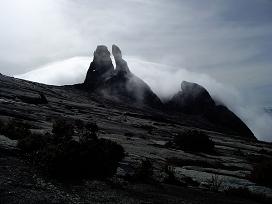
|
| "Donkey Ears" rock formation. |
The hiking route is obvious and well-traveled. It is muddy in many places, with stairsteps cut to lower the effect of erosion. Some steps are quite tall, exceeding one foot. One annoyance is that the trail is nonuniform in grade. It is nearly level in some parts, and somewhat steep (at least for a trail) in others.
There are many porters descending the route, having taken a load of material for the huts and returning with a second batch. I am surprised at their small stature - short and wiry, and perhaps 20 years average age. Yet the loads seem large enough to tax anybody back in the states. I am only 5 foot 7 inches - and yet taller than most locals. And they don't weigh more than 55 kilos (120 pounds) with some only 45 kilos and less. I am impressed with their efforts.

|
| Adam (front) and Bob at summit. |
The recommended time "up" to the huts is five hours. Robert and I make the ascent in some 3 hours 40 minutes, having encountered heavy rain only at the very end. Later Bob, accompanied by the guide, arrives soaking wet in the standard time. He slumps in a seat.
Robert seems to be in great shape, and this allows him to go birding on-trail while still managing to keep pace with myself. I manage to keep pace with him, but just barely.
A buffet supper sets us back about 26 Ringgit each, some seven or eight dollars. The fried noodles and assorted cuts of meat are quite tasty, and certainly more so than the ubiquitous piles of white rice.
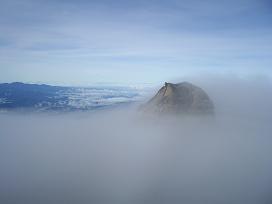
|
|
Clouds lend new dimension to the summit vista. |
The standard protocol is to start for the summit early enough as to greet the sunrise. We have each witnessed and enjoyed many a sunrise from mountaintops; and, given that we desperately need sleep, basically refuse to arise at 2 a.m. for this touristy nonsense. We suggest a dawn start to the guide, who promptly objects, citing that park regulations call for leaving no later than 5 a.m. We agree to this compromise time (there appears to be no choice) and turn-in.
The first hour is by dark as we grope by headlamp up stairs, often with railing, atop wet rocks and moss. The rails are helpful because of the slippery terrain. Later, and after gaining perhaps one thousand feet, a short yet steep section is climbed over room-size boulders and protected by rope - certainly a new and stimulating experience for the majority of those here.

|
|
Low's Peak - highest summit of the Kinabalu massif. |
A checkpoint is reached in the morning chill some halfway to the summit. Above is pure granite, the route shallow, and, remarkably, protected with a heavy rope despite the nearly nonexistent grade. Presumably the rope keeps one on-route during a whiteout. Indeed, the clouds make for poor visibility - and I can easily imagine a tourist, without map and compass skills, getting lost were it not for the rope and the (mandatory) guide.
The majority of hikers descend past us. They are appropriately well-dressed with heavy layers, gloves, and ski hats. Many are Malaysian, some are Japanese, some are Caucasian, and all are happy from having reached the top.
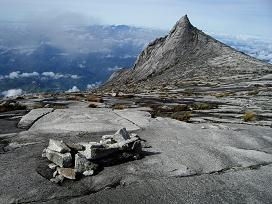
|
|
The route is generally shallow. Glacier-carved horn in mid-ground. |
Somehow I get ahead of the others, and, after negotiating the final 200-or-so vertical feet (which is moderately steep), reach the summit under blustery conditions with little visibility. It is just after 7:30 a.m.
Shortly after Robert and Bob arrive the sky opens, and we are treated to excellent views of nearby peaks on the Kinabalu massif - some of which appear to be as high as ourselves. I am concerned, and remain so to some degree, that our peak, Low's Peak, may not be the true highest point on this mountain. The other peaks are technical, rarely climbed, and present far greater challenges than this near walk-up.
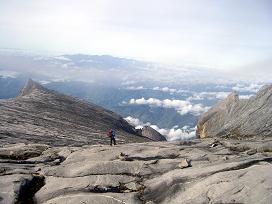
|
|
Descent on granite slopes. Adam in mid-ground. |
We descend under clear skies, savoring the improved weather and our minor victory. By late morning we are back at the main Laban Rata hut, and, after an hour's rest that I insist upon, we enjoy a large lunch before descending all the way to base. I struggle to finish the sizeable bowl of hot soup stuffed with noodles and seafood - too spicy for Robert and of little interest to Bob who orders a sandwich. I do, however, feel energized for much of the 5,000 foot descent.
That evening we take a room in one of the several lodges near the park entrance. It is hot and humid, and I would trade the modest chill of the upper huts in a flash for this sultry and enervating weather. A few mosquitoes invade our room - a serious issue in these parts.
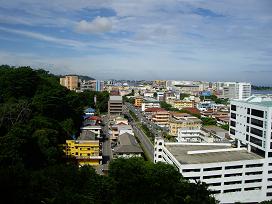
|
| central Kota Kinabalu |
Having climbed the peak our sole reason for visiting Borneo is through. Yet our return flight to Kuala Lumpur leaves us with two days of little to do but play tourist. We return to KK and attempt to gainfully occupy our time.
Finances become a serious issue. None of our credit cards function at ATM machines - and, without ready cash, our journey is jeopardized. I call Ruhaizad and we meet in his office. There we describe the situation and he assists us in whatever manner he is able to. A call to my credit card company allows my card to function; and Bob has similarly good fortune with his card. Robert's card still won't budge - and this despite multiple calls to his company back in the UK.
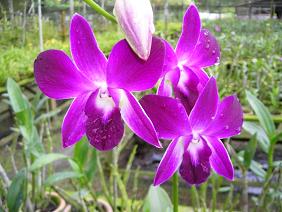
|
|
The orchid garden features hundreds of varieties. |
We arrange to meet Ruhaizad for dinner at a fancy seafood restaurant by the docks. Upon leaving him we three enjoy snacks at the Veda ice cream parlor a few blocks from our hostel. The ice cream is creamy and delectable.
Dinner is enormous, varied, tasty. Without any climbing for the duration I am overeating, and so feel hugely uncomfortable from pouring sweat and humidity. I am so hot that I cannot enjoy the food. I vow to not consume large amounts of food again until after sundown - it simply generates too much heat given the already sultry climate. I begin to appreciate why nearly everybody here is thin - it dissipates heat more efficiently.
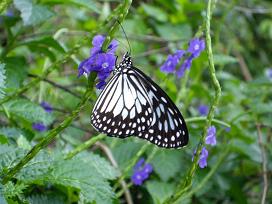
|
| butterfly and flowers |
One afternoon we visit an orchid garden an hour drive north of town, and are treated to a private tour by an orchid expert who derives pleasure in citing the scientific name of every plant he describes. It is well worth the time to see these plants with remarkable, diverse, colorful adaptations.
We also visit KK's Museum of Nature and Science. Close-by is the Museum of Islamic Culture. The former is not air-conditioned except for the main building. The latter is conditioned, and this distinction makes a world of difference in these parts.
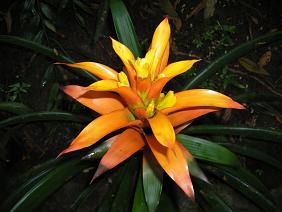
|
| orange-colored inflorescence |
The return ride from the museums to our backpacker's hostel is interesting. The taxi driver, a Chinese by birth, simply gets lost. He calls his wife for instructions, and eventually we three tell him how to reach our hostel. I have never seen more inept navigation than from this man who, as a taxi driver, presumably should know his own city's streets!
Supper our final night in KK is at Restauran Baru ("New Restaurant"), and, although clearly owned by Muslims, features standard Malaysian fare. After I translate the menu items for Bob and Robert, Bob gets the mie goreng seafood ("fried noodles with seafood"), a dish that he cannot get enough of during our travels. We are full after some $6 in food - a remarkably cheap price for three meals that stateside would have cost several times more. This phenomenon - cheap yet filling meals at simple establishments, would highlight our journeys.
Our flight to Kuala Lumpur the next morning is uneventful. We tried to secure earlier flights at a tourist office in KK; and yet found either the Kuala Lumpur- and/or Bali-bound leg to be full. Further, the charge for switching flights is prohibitive. So much for hiring Air Asia - a "discount" air carrier.
9Horns are sharp mountains carved on three sides by glaciers. The most famous example is probably Switzerland's Matterhorn.
| previous page - Concept, Goals, Language | next page - Gunung Rinjani |